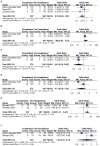Post-acute COVID-19 symptom risk in hospitalized and non-hospitalized COVID-19 survivors: A systematic review and meta-analysis
- PMID: 36875356
- PMCID: PMC9978404
- DOI: 10.3389/fpubh.2023.1112383
Post-acute COVID-19 symptom risk in hospitalized and non-hospitalized COVID-19 survivors: A systematic review and meta-analysis
Abstract
Background: Post-acute coronavirus disease 2019 (COVID-19) symptoms occurred in most of the COVID-19 survivors. However, few studies have examined the issue of whether hospitalization results in different post-acute COVID-19 symptom risks. This study aimed to compare potential COVID-19 long-term effects in hospitalized and non-hospitalized COVID-19 survivors.
Methods: This study is designed as a systematic review and meta-analysis of observational studies. A systematic search of six databases was performed for identifying articles published from inception until April 20th, 2022, which compared post-acute COVID-19 symptom risk in hospitalized and non-hospitalized COVID-19 survivors using a predesigned search strategy included terms for SARS-CoV-2 (eg, COVID, coronavirus, and 2019-nCoV), post-acute COVID-19 Syndrome (eg, post-COVID, post COVID conditions, chronic COVID symptom, long COVID, long COVID symptom, long-haul COVID, COVID sequelae, convalescence, and persistent COVID symptom), and hospitalization (hospitalized, in hospital, and home-isolated). The present meta-analysis was conducted according to The Preferred Reporting Items for Systematic Reviews and Meta-Analyses (PRISMA) 2020 statement using R software 4.1.3 to create forest plots. Q statistics and the I 2 index were used to evaluate heterogeneity in this meta-analysis.
Results: Six observational studies conducted in Spain, Austria, Switzerland, Canada, and the USA involving 419 hospitalized and 742 non-hospitalized COVID-19 survivors were included. The number of COVID-19 survivors in included studies ranged from 63 to 431, and follow-up data were collected through visits in four studies and another two used an electronic questionnaire, visit and telephone, respectively. Significant increase in the risks of long dyspnea (OR = 3.18, 95% CI = 1.90-5.32), anxiety (OR = 3.09, 95% CI = 1.47-6.47), myalgia (OR = 2.33, 95% CI = 1.02-5.33), and hair loss (OR = 2.76, 95% CI = 1.07-7.12) risk were found in hospitalized COVID-19 survivors compared with outpatients. Conversely, persisting ageusia risk was significantly reduced in hospitalized COVID-19 survivors than in non-hospitalized patients.
Conclusion: The findings suggested that special attention and patient-centered rehabilitation service based on a needs survey should be provided for hospitalized COVID-19 survivors who experienced high post-acute COVID-19 symptoms risk.
Keywords: COVID-19 survivor; hospitalized; long-COVID; meta-analysis; non-hospitalized; post-acute COVID-19 symptom.
Copyright © 2023 Yuan, Lv, Sun, Wen, Tao, Qian, Tao and Yu.
Conflict of interest statement
The authors declare that the research was conducted in the absence of any commercial or financial relationships that could be construed as a potential conflict of interest.
Figures






Similar articles
-
The burden of persistent symptoms after COVID-19 (long COVID): a meta-analysis of controlled studies in children and adults.Virol J. 2024 Jan 11;21(1):16. doi: 10.1186/s12985-024-02284-3. Virol J. 2024. PMID: 38212781 Free PMC article.
-
Long COVID: rheumatologic/musculoskeletal symptoms in hospitalized COVID-19 survivors at 3 and 6 months.Clin Rheumatol. 2022 Jan;41(1):289-296. doi: 10.1007/s10067-021-05942-x. Epub 2021 Oct 29. Clin Rheumatol. 2022. PMID: 34713356 Free PMC article.
-
Prevalence of post-COVID-19 symptoms in hospitalized and non-hospitalized COVID-19 survivors: A systematic review and meta-analysis.Eur J Intern Med. 2021 Oct;92:55-70. doi: 10.1016/j.ejim.2021.06.009. Epub 2021 Jun 16. Eur J Intern Med. 2021. PMID: 34167876 Free PMC article.
-
Assessment of the Frequency and Variety of Persistent Symptoms Among Patients With COVID-19: A Systematic Review.JAMA Netw Open. 2021 May 3;4(5):e2111417. doi: 10.1001/jamanetworkopen.2021.11417. JAMA Netw Open. 2021. PMID: 34037731 Free PMC article.
-
Virtualized clinical studies to assess the natural history and impact of gut microbiome modulation in non-hospitalized patients with mild to moderate COVID-19 a randomized, open-label, prospective study with a parallel group study evaluating the physiologic effects of KB109 on gut microbiota structure and function: a structured summary of a study protocol for a randomized controlled study.Trials. 2021 Apr 2;22(1):245. doi: 10.1186/s13063-021-05157-0. Trials. 2021. PMID: 33810796 Free PMC article.
Cited by
-
Longitudinal Changes in Physical Function and Their Impact on Health Outcomes in COVID-19 Patients.Nutrients. 2023 Oct 22;15(20):4474. doi: 10.3390/nu15204474. Nutrients. 2023. PMID: 37892549 Free PMC article.
-
Epidemiological and clinical characteristics of long COVID-19 among Iranians: A community-based study in southern Iran.BMC Public Health. 2024 Jul 26;24(1):2007. doi: 10.1186/s12889-024-19543-1. BMC Public Health. 2024. PMID: 39061051 Free PMC article.
-
Prevalences and Interrelationships of Post COVID-19 Fatigue, Sleep Disturbances, and Depression in Healthy Young and Middle-Aged Adults.J Clin Med. 2024 May 9;13(10):2801. doi: 10.3390/jcm13102801. J Clin Med. 2024. PMID: 38792343 Free PMC article.
-
Health-Related Quality of Life and Functional Status of Post-COVID-19 Patients.Int J Environ Res Public Health. 2025 Feb 25;22(3):338. doi: 10.3390/ijerph22030338. Int J Environ Res Public Health. 2025. PMID: 40238313 Free PMC article.
-
Elevated adipokines and myokines are associated with fatigue in long COVID patients.Front Med (Lausanne). 2025 May 19;12:1547886. doi: 10.3389/fmed.2025.1547886. eCollection 2025. Front Med (Lausanne). 2025. PMID: 40458645 Free PMC article.
References
Publication types
MeSH terms
LinkOut - more resources
Full Text Sources
Medical
Miscellaneous

